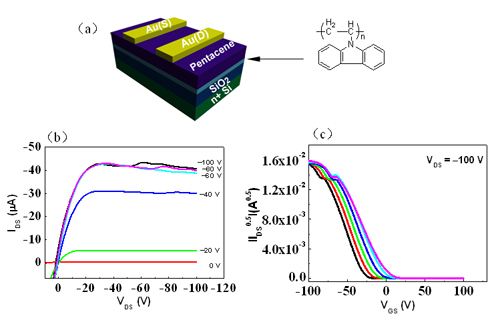| |
By Ying Wang, Yunqi Liu,* Yabin Song, Shanghui Ye, Weiping Wu, Yunlong Guo, Chong-an Di, Yanming Sun, Gui Yu and Wenping Hu
Organic field-effect transistors (FETs), as the critical components of organic integrated circuits (ICs), have attracted considerable attention due to their low cost, easy processability, flexibility, and applicability to large-area devices. However, there are still many challenges, which can impede organic FETs from practical application in organic ICs. The major challenges remaining are the decrease of the pinch-off voltage (VP) and precise control of the threshold voltage (VT).
In this paper, OFETs with a poly(N-vinylcarbazole) (PVK) buffer layer between SiO2 and organic semiconductors are fabricated. The PVK buffer layer not only improves the performance of the devices (the mobility up to 0.5 cm2 V-1s-1) but also sharply reduces the absolute value of the pinch-off voltage at different VGS down to lower than 20 V. More interestingly, the number of charges stored in PVK layer can be changed by the starting VGS, resulting in the systematically control of threshold voltage in a single device.
Advanced Materials., (2008, 20(3), .611-615)

Figure 1. a) Molecular structure of PVK and the cross-sectional view of organic FETs. b) Output characteristic of pentacene FETs with PVK buffer layer. c) Output characteristic of pentacene FETs without a PVK buffer layer. , |
|
